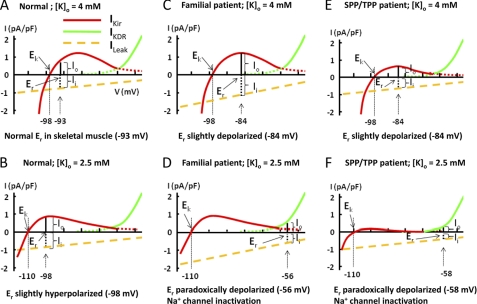FIGURE 7.
Schematic models illustrating reduced outward current of Kir could induce paradoxical depolarization in patients with Kir2.6 mutation. The steady-state current-voltage (I-V) relationship curve for K+ current in mammalian skeletal muscle is a combination of I-V curves of inward rectifying K+ channel (Kir, red line) and delayed rectifying K+ channel (KDR, green line). Leakage current (yellow dotted line) has a reversal potential of 0 mV. Because gating pore currents from mutations of the voltage sensor only occur in hyperpolarized potentials, the inward leak current in familial hypoKPP patients is not linear (not illustrated here). The model is intended for conceptual understanding. The numerical value may be slightly different from the true in vivo value. See “Discussion” and Struyk and Cannon (19) for details. Ek, equilibrium potential of Kir channel; Er, resting membrane potential; Io, outward cation current; Ii, inward cation current; IKir, current of inward rectifying potassium channel; IKDR, current of delayed rectifying potassium channel; ILeak, inward cation leak current; [K]o, extracellular potassium concentration.

